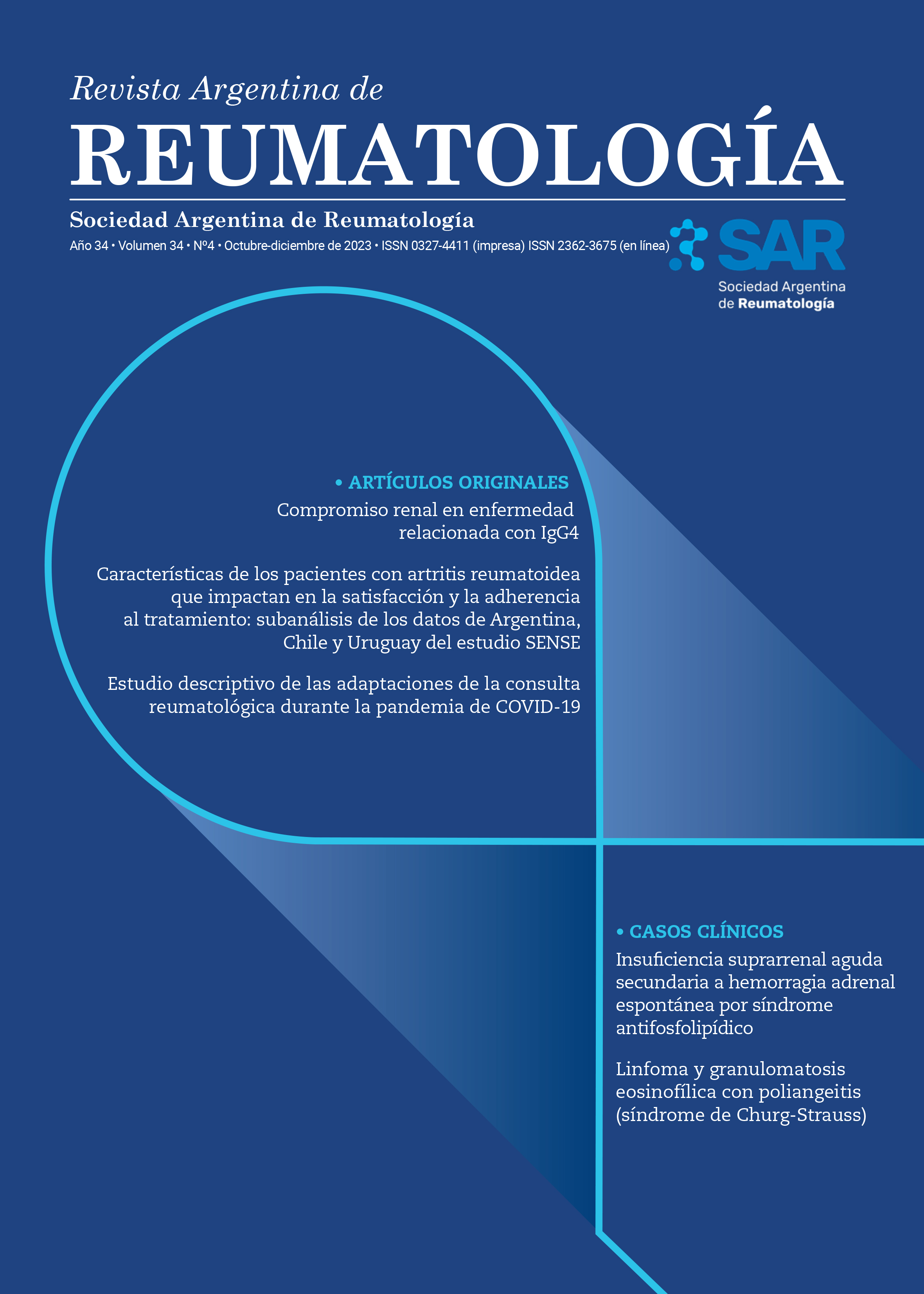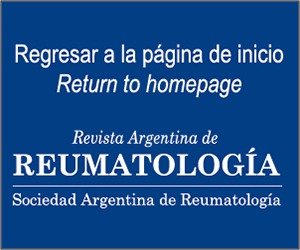Estudio descriptivo de las adaptaciones de la consulta reumatológica durante la pandemia de COVID-19
Resumen
Introducción: La pandemia de COVID19 tuvo un gran impacto en la sociedad en general. El aislamiento impuesto modificó las relaciones interpersonales, incluyendo las consultas médicas. Objetivos: describir las consultas reumatológicas en el Servicio de Reumatología del Instituto de Rehabilitación Psicofísica (IREP) durante la pandemia por COVID-19, y compararlas con las recibidas durante 2019. Materiales y métodos: estudio observacional. Se registraron las consultas recibidas durante marzo-septiembre de 2020. Se recolectaron datos sociodemográficos, número y motivo de las consultas realizadas por paciente. Se llevó a cabo un análisis de regresión logística múltiple para estimar las variables asociadas a la consulta presencial. Resultados: se registraron 1.703 consultas; 798 pacientes consultaron al menos una vez, la mediana de consulta por paciente fue de 3 (RIC 1-12). La principal vía de consulta fue por correo electrónico (57%), solo el 13% fue de forma presencial. El principal motivo fue la solicitud de recetas (60%) seguido por consultas por la enfermedad (23%). Se observó una reducción del total de las consultas con respecto al año previo del 57% (3.961) y una reducción mayor del 94% en el número de consultas presenciales (224). La consulta médica presencial durante la pandemia se asoció independientemente con el sexo masculino (OR: 2.4 IC 95% 1,6-3,6), la consulta por enfermedad de base (OR: 5.8 IC 95% 4,1-8,3) y la ausencia de cobertura social (OR: 2.3 IC 95% 1,6-3,3). Conclusiones: las consultas reumatológicas, especialmente las presenciales, disminuyeron sustancialmente durante la pandemia.Citas
I. Kaye AD, Okeagu CN, Pham AD, Silva RA, Hurley JJ, et al. Economic impact of COVID-19 pandemic on healthcare facilities and systems: international perspectives. Best Pract Res Clin Anaesthesiol 2021;35(3):293-306.
II. Both LM, Zoratto G, Calegaro VC, Ramos-Lima LF, Negretto BL, et al. COVID-19 pandemic and social distancing: economic, psychological, family, and technological effects. Trends Psychiatry Psychother 2021;43(2):85-91.
III. Kretchy IA, Asiedu-Danso M, Kretchy JP. Medication management and adherence during the COVID-19 pandemic: perspectives and experiences from low-and middle-income countries. Res Social Adm Pharm 2021;17(1):2023-2026.
IV. Di Fusco M, Shea KM, Lin J, Nguyen JL, Angulo FJ, et al. Health outcomes and economic burden of hospitalized COVID-19 patients in the United States. J Med Econ 2021;24(1):308-317.
V. Varona L, Gonzales JR. Dynamics of the impact of COVID-19 on the economic activity of Peru. PLoS One 2021 8;16(1):e0244920
VI. Ministerio de Salud de la Nación Argentina. Disponible en: https://www.argentina.gob.ar/noticias/salud-confirma-el-primer-caso-de-coronavirus-en-el-pais. Consultado: 11/4/2020.
VII. Boletín Oficial. Disponible en: www.boletinoficial.gob.ar/detalleAviso/primera/227042/20200320. Consultado: 11/4/2020.
VIII. World Health Organization. Disponible en: www.covid19.who.int. Consultado: 15/4/2020.
IX. BBC News. Disponible en: www.bbc.com/mundo/noticias-internacional-53892496. Consultado: 28/8/2020.
X. Johns Hopkins Coronavirus Resource Center. Disponible en: www.coronavirus.jhu.edu. Consultado: 5/9/2020.
XI. Ministerio de Salud de la Nación Argentina. Disponible en: www.argentinagob.gob.ar/salud/coronavirus-covid-19/sala-situacion. Consultado: 10/9/2020.
XII. Monti S, Balduzzi S, Delvino P, Bellis E, Quadrelli VS, et al. Clinical course of COVID-19 in a series of patients with chronic arthritis treated with immunosuppressive targeted therapies. Ann Rheum Dis 2020;79(5):667-8.
XIII. Calabrese C. COVID-19 and your rheumatology patients. Cleve Clin J Med 2020;10.3949/ccjm.87a.ccc027.
XIV. Santos CS, Morales CM, Álvarez ED, Castro CÁ, Robles AL, Sandoval TP. Determinants of COVID-19 disease severity in patients with underlying rheumatic disease. Clin Rheumatol 2020;39(9):2789-96.
XV. Isnardi CA, Gómez G, Quintana R, Roberts K, Berbotto G, Báez RM, et al. Características epidemiológicas y desenlaces de la infección por SARS-CoV-2 en pacientes con patologías reumáticas: primer reporte del registro argentino SAR-COVID. Rev Arg Reumatol 2021;32(1):7-15.
XVI. Richez C, Flipo RM, Berenbaum F, et al. Managing patients with rheumatic diseases during the COVID-19 pandemic: The French Society of Rheumatology answers to most frequently asked questions up to May 2020. Joint Bone Spine 2020;S1297-319X(20)30092-0.
XVII. Fragoulis GE, Evangelatos G, Arida A, et al. Treatment adherence of patients with systemic rheumatic diseases in COVID-19 pandemic. Ann Rheum Dis 2020;80(4):e60.
XVIII. Phadke NA, Del Carmen MG, Goldstein SA, et al. Trends in ambulatory electronic consultations during the COVID-19 pandemic. J Gen Intern Med 2020;1-3.
XIX. Nune A, Iyengar K, Ahmed A, Sapkota H. Challenges in delivering rheumatology care during COVID-19 pandemic. Clin Rheumatol 2020;39(9):2817-2821.
XX. Masini F, Gjeloshi K, Ferrara R, Pinotti E, Cuomo G. Rheumatic disease management in the Campania region of Italy during the COVID-19 pandemic. Rheumatol Int 2020;40(9):1537-1538.
XXI. Guaracha-Basáñez GA, Contreras-Yáñez I, Hernández-Molina G, González-Marín A, Pacheco-Santiago LD, et al. Clinical and bioethical implications of health care interruption during the COVID-19 pandemic: a cross-sectional study in outpatients with rheumatic diseases. PLoS One 2021 Jul 9;16(7):e0253718.
XXII. Adnine A, Soussan I, Nadiri K, Coulibaly S, Berrada K, et al. Patients with rheumatic diseases overlooked during COVID-19 pandemic: how are they doing and behaving? Curr Rheumatol Rev 2021 Aug 30;17(3):318-326.
XXIII. Opinc A, Brzezińska O, Makowska J. The impact of COVID-19 and healthcare system changes on the well-being of rheumatic patients. Reumatol 2021;59(2):73-84.
XXIV. George MD, Baker JF, Banerjee S, Busch H, Curtis D, et al. Social distancing, health care disruptions, telemedicine use, and treatment interruption during the COVID-19 pandemic in patients with or without autoimmune rheumatic disease. ACR Open Rheumatol 2021 Jun;3(6):381-389.
XXV. Hassen LM, Almaghlouth IA, Hassen IM, Daghestani MH, Almohisen AA, et al. Impact of COVID-19 outbreak on rheumatic patients' perceptions and behaviors: A cross-sectional study. Int J Rheum Dis 2020 Nov;23(11):1541-1549.
XXVI. Naddei R, Alfani R, Bove M, Discepolo V, Mozzillo F, et al. Increased relapse rate during COVID-19 lockdown in an Italian cohort of children with juvenile idiopathic arthritis. Arthritis Care Res (Hoboken) 2021;75(2):326-331.
XXVII. Avouac J, Molto A, Frantz C, Wanono S, Descamps E, Fogel O, et al. Evaluation of patients with rheumatoid arthritis in teleconsultation during the first wave of the COVID-19 pandemic. J Rheumatol 2022;49(11):1269-1275.
XXVIII. Di Iorio M, Cook CE, Vanni KMM, Patel NJ, D'Silva KM et al. DMARD disruption, disease flare, and prolonged symptom duration after acute COVID-19 among participants with rheumatic disease: A prospective study. Semin Artrhritis Rheum 2022;55:152025.
Derechos de autor 2023 a nombre de los autores. Derechos de reproducción: Sociedad Argentina de Reumatología

Esta obra está bajo licencia internacional Creative Commons Reconocimiento-NoComercial-SinObrasDerivadas 4.0.






